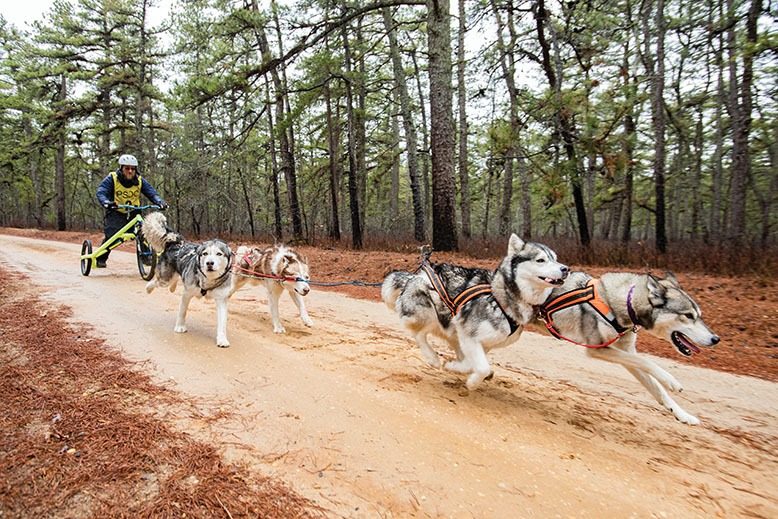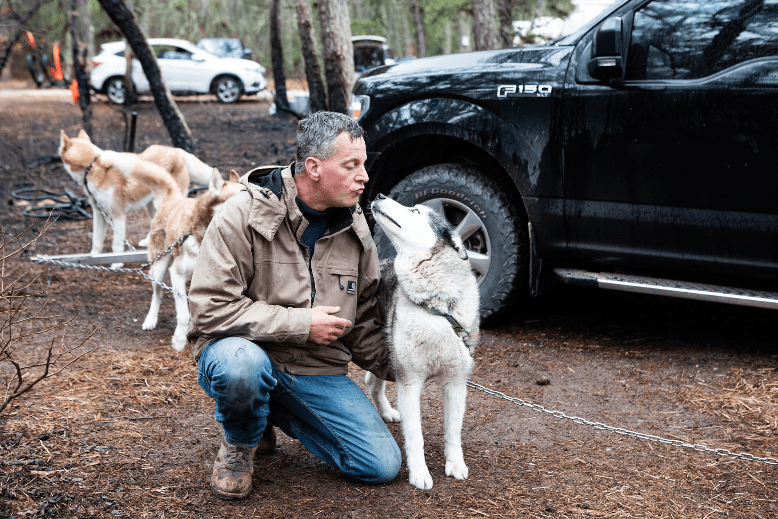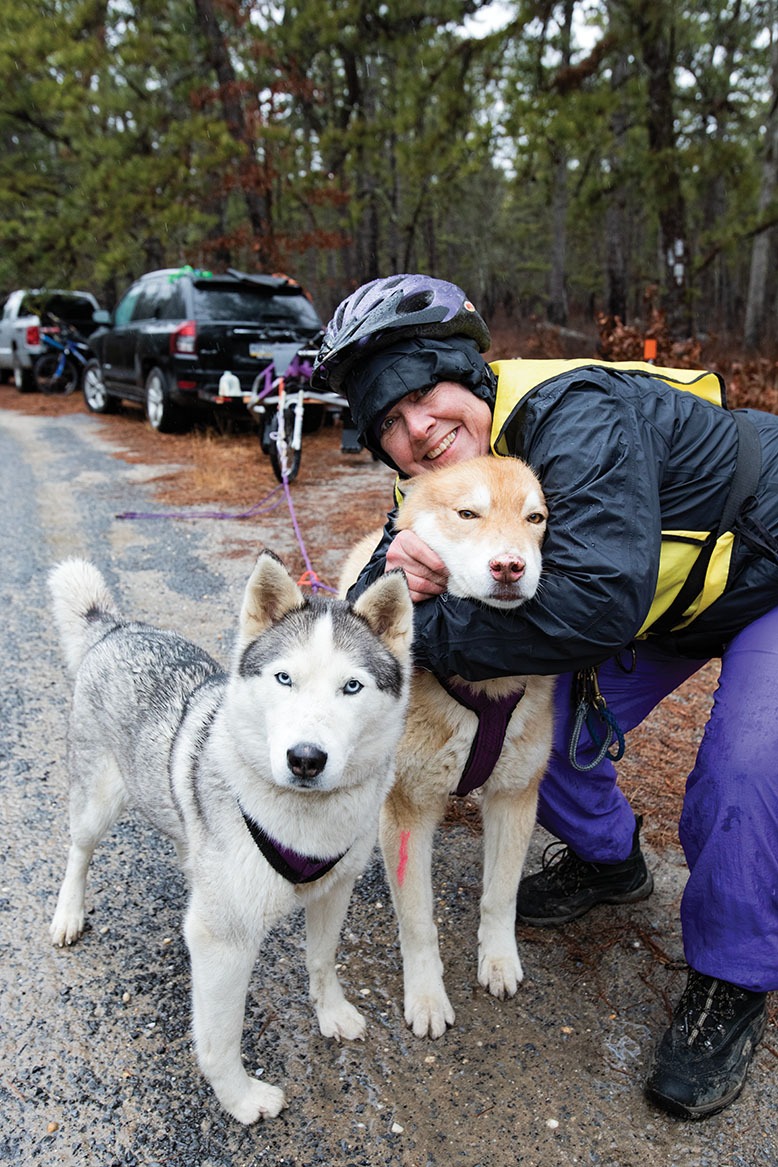
The soft sounds of nature—rustling leaves and birds chirping—engulf me as I enter Brendan T. Byrne State Forest. About three miles in, a cacophony of excited barks and howls begins. I arrive at the meeting spot for the Jersey Sands Sled Dog Racing Association (JSSDRA), and the calls of two dozen dogs are piercing. On this mid-February day, it’s a brisk 32 degrees and sunny—ideal conditions for dry-land mushing, or non-snow dog sledding.
About 15 dog owners from New Jersey, Pennsylvania and Maryland and their canines are here for an informal training session coordinated by Bryan Freeman, president of the JSSDRA. He’s accompanied by his seven dogs: five Siberian huskies and two Labs. “These are my pets. I do this for fun. It’s a hobby,” he says. His license plate, which reads SLEDOGZ, indicates it’s something more. “It’s a lifestyle,” he adds.
It is a lifestyle he’s been practicing for 30 years. Freeman was introduced to dog sledding by a stranger in a park. “He said, ‘We meet up in the woods. We have equipment you can borrow,’” explains Freeman. “I came out, got hooked, and have been doing it ever since.”

Bryan Freeman is the president of the Jersey Sands Sled Dog Racing Association (JSSDRA). Photo: Joe Polillio
Now, Freeman, an electrician who lives in Clayton, is the one coordinating practices in the New Jersey Pinelands.
Everyone from experienced mushers to first-timers is welcome to join the trainings, but you must bring your own dog to participate. Freeman spreads the word about these gatherings on the association’s Facebook page with the location coordinates, date and time.
While some members view it as a recreational sport and a way to bond with their dogs and fellow animal lovers, others take it more seriously, participating in racing circuits throughout the country. The JSSDRA collaborates with a Pennsylvania club to run a few races per year, and members train together at the race sites, weather permitting.
This year, their season runs until March.
“We’re a training-learning club. We’ll teach people, and they’ll go however high a level they want to take it—to race [or] to just be out here with their dog,” Freeman explains.
Although Freeman acknowledges dog sledding is “an expensive hobby and not a popular sport in New Jersey,” he says the club works to promote it and “try to keep the interest alive.”
MORE WINTER FUN:
Join NJ’s Curling Craze
Quirky Places to Go Ice-Skating
Where to Cross-Country Ski in NJ
Beat the Cold with Cozy Indoor Activities
After a few minutes, I adjust to the deafening sounds of the eager canines. They are champing at the bit to hit the sandy trail.
The first pack, a team of six Eurohounds, poke their heads out of the back window of their owner’s car. They’ll pull my chariot, or rig—think a metal cart with bicycle-like tires—that’s currently fastened to a tree. A seasoned musher will guide the dogs on my ride.
I sign a waiver and strap on a helmet. As this group is hooked up to the rope stretched out in front of the rig—a minimum two-person job—the other dogs who have to wait their turns get louder. They seem jealous that they’re not the ones about to embark on the 3.8-mile trail.
The front dogs are harnessed first so the line is pulled taut. This makes it easier to strap in the rest. They stare straight forward, fixated on the trail. I plop down on a small pillow on the front of the rig, directly behind the dogs. I have a front-row seat.
The musher stands behind me on the cart. She makes sure I’m comfortable, and off we go on this dog-powered adventure. Seconds in, I get my first mouthful of sand that the dogs kick up from the trail. I get used to having debris in my face and begin to marvel at the endurance of these six canines.
For about 15 minutes, they run in unison at about 20 miles per hour. Pulling two people is not easy for the pack, but they seem motivated by the musher’s encouragement. “Good dogs, good dogs,” she yells every few minutes, especially when we veer around tighter corners, traverse a puddle, and maneuver through piles of deeper sand. Ears pressed to their heads and tongues wagging in the wind, each dog fulfills a role in the pack. The front dogs, called lead dogs, are the most intelligent on the team. The middle two hounds are known as team dogs; they steer the pack. The back pair, positioned closest to the rig, are the strongest, known as wheel dogs.
As we partake in this exhilarating form of forest bathing, I feel as though I am on a small roller coaster, sans stomach drops. I can’t help but smile as the cold breeze makes my eyes tear.
I can tell we’re nearing the end of the trail as the dogs slow to a trot.
When we’re back at home base, the dogs are immediately given big bowls of water. That’s it for the day for this team. Soon, another team will get in formation to hit the trail.

JSSDRA members are wilderness enthusiasts, thrill seekers and, above all, dog lovers. Photo: Joe Polillio
The joyride is thrilling, but a lot of preparation is required. As a rule of thumb, the temperature plus the humidity should equal about 110. “We typically don’t want to go out above 50 degrees,” explains Freeman.
As far as terrain, dirt or sand is best for the dogs when snow isn’t available. When the snow is deep enough, the group breaks out sleds instead of rigs and trains, though, as Freeman says, “we don’t have the snow we used to get in years past.”
The correct gear is essential. The ropes have bungees in them to help with shock absorption. Special mushing harnesses are needed so the dogs are protected.
Typically, once dogs are about a year old, they can try the sport. Fitness is also a main factor. “These guys are athletes,” says Freeman.
The newer dogs in today’s session are slower and zigzag across the trail. Sometimes, Freeman will pair a novice with a more seasoned dog to help them learn. On average, once they’re about 10 years old, the dogs stop running. When it’s time to retire, “we’ll see signs,” says Freeman.
While it’s true that Alaskan malamutes and Siberian huskies are bred to sled, and hounds, with their speed and short coats, are also good candidates, any dog breed can participate in this sport. Musher Meredith Michener of Collegeville, Pennsylvania, for example, started out with her boxer, Leo. “He self-selected as a sled dog,” she says. Now, Michener competes with Kona, a 6-year-old pointer-greyhound mix.
When asked if the dogs, who are clearly excited, actually enjoy mushing, many handlers explain a core philosophy of the sport: you can’t push a rope. In other words, you can’t force the dogs to participate.
What does Freeman say to critics? “The only proof in positivity is to come out and experience it,” he says. “We invite people to watch and see that we’re here for the sheer enjoyment of the dogs, to see how happy the dogs are. These dogs were born to run.”
“I can see both sides,” he adds about those who feel dog sledding is not humane. But, he explains, the stigma may come more from dog sledding that takes place farther north, where canines in larger kennels are trained for long-distance races that last multiple days and have high-dollar purses. Dogs in JSSDRA are “sprint racers,” running short distances.
[RELATED: NJ’s Christmas Bird Count Is Humane Alternative to Holiday Hunting Tradition]
Bundled in layers, with chapped faces and dirt under their fingernails, dog sledding folk, or at least, this group that welcomed me into their culture for a few hours, are a cross between wilderness lovers, thrill seekers and dog enthusiasts.
Take Kirsti LaVoy. She and her husband drove three hours from Mt. Airy, Maryland, with seven of their 11 malamutes. Her team mainly trains with a rig, but they’ve also traversed snow in the Midwest. “The sled is magical,” she says.
Dawna Eddinger of Perkiomenville, Pennsylvania, became involved in mushing while searching for a way to exercise her malamutes. “Since they’re working dogs, walking them is not enough,” she says. Eddinger, her husband and their pooches, Ketchikan and Kora, also enjoy the quality time in nature that dog sledding offers. “It’s just so peaceful,” she says.
Michener has taken mushing from a recreational hobby to a competitive sport, but says there is still a real feeling of togetherness among enthusiasts.
“A lot of us, when we’re on a race circuit, we camp, too. It’s a lot of fun,” she says. “It’s been a great community. We’re all dog people. We’re all outdoor people.”
Jacqueline Larcara is the editor of New Jersey Bride and a former associate editor for New Jersey Monthly.
No one knows New Jersey like we do. Sign up for one of our free newsletters here. Want a print magazine mailed to you? Purchase an issue from our online store.



